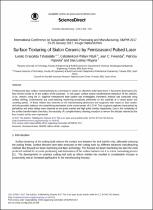JavaScript is disabled for your browser. Some features of this site may not work without it.
- ResearchSpace
- →
- Research Publications/Outputs
- →
- Conference Publications
- →
- View Item
| dc.contributor.author |
Tshabalala, Lerato C

|
|
| dc.contributor.author |
Ntuli, CP

|
|
| dc.contributor.author |
Fwamba, JC

|
|
| dc.contributor.author |
Popoola, P

|
|
| dc.contributor.author |
Pityana, Sisa L

|
|
| dc.date.accessioned | 2017-09-18T06:48:10Z | |
| dc.date.available | 2017-09-18T06:48:10Z | |
| dc.date.issued | 2017-01 | |
| dc.identifier.citation | Tshabalala, L.C., Ntuli, C.P., Fwamba, J.C. et al. 2017. Surface texturing of sialon ceramic by femtosecond pulsed laser. International Conference on Sustainable Materials Processing and Manufacturing (SMPM), 23-25 January 2017, Kruger National Park, South Africa | en_US |
| dc.identifier.uri | https://doi.org/10.1016/j.promfg.2016.12.098 | |
| dc.identifier.uri | http://www.sciencedirect.com/science/article/pii/S235197891630261X | |
| dc.identifier.uri | http://hdl.handle.net/10204/9563 | |
| dc.description | International Conference on Sustainable Materials Processing and Manufacturing (SMPM), 23-25 January 2017, Kruger National Park, South Africa. Published in Procedia Manufacturing 7 (2017), pp. 660-667 | en_US |
| dc.description.abstract | Femtosecond laser surface micromachining is a technique in which an ultrashort pulse laser beam is focused to dimensions of a few microns inside or on the surface of the substrate. In this paper, surface texture transformation behaviour of the SiAlONSi(sub3)N(sub4) ceramic using the Ti: Sapphire Femtosecond laser system was investigated. Parametric analysis was conducted using surface drilling, unidirectional and cross-hatching machining procedures performed on the substrate at a varied power and scanning speeds. A linear relation was observed on the microtexturing dimensions and roughness with respect to laser powers and this provided optimum micromachining mechanism at the chosen power of 0.25 W. Two roughness regimes characterised by periodicity and sharp valleys were observed at low pulse overlap and high pulse overlap respectively. Due to the complexity of the surface transformation chemistry, the necessity of a complementary cleaning procedure to remove the silicates retained by the laser treated surface was emphasised. | en_US |
| dc.language.iso | en | en_US |
| dc.publisher | Elsevier | en_US |
| dc.relation.ispartofseries | Worklist;19420 | |
| dc.subject | Femotosecond pulsed laser | en_US |
| dc.subject | Sialon ceramic | en_US |
| dc.title | Surface texturing of sialon ceramic by femtosecond pulsed laser | en_US |
| dc.type | Conference Presentation | en_US |
| dc.identifier.apacitation | Tshabalala, L. C., Ntuli, C., Fwamba, J., Popoola, P., & Pityana, S. L. (2017). Surface texturing of sialon ceramic by femtosecond pulsed laser. Elsevier. http://hdl.handle.net/10204/9563 | en_ZA |
| dc.identifier.chicagocitation | Tshabalala, Lerato C, CP Ntuli, JC Fwamba, P Popoola, and Sisa L Pityana. "Surface texturing of sialon ceramic by femtosecond pulsed laser." (2017): http://hdl.handle.net/10204/9563 | en_ZA |
| dc.identifier.vancouvercitation | Tshabalala LC, Ntuli C, Fwamba J, Popoola P, Pityana SL, Surface texturing of sialon ceramic by femtosecond pulsed laser; Elsevier; 2017. http://hdl.handle.net/10204/9563 . | en_ZA |
| dc.identifier.ris | TY - Conference Presentation AU - Tshabalala, Lerato C AU - Ntuli, CP AU - Fwamba, JC AU - Popoola, P AU - Pityana, Sisa L AB - Femtosecond laser surface micromachining is a technique in which an ultrashort pulse laser beam is focused to dimensions of a few microns inside or on the surface of the substrate. In this paper, surface texture transformation behaviour of the SiAlONSi(sub3)N(sub4) ceramic using the Ti: Sapphire Femtosecond laser system was investigated. Parametric analysis was conducted using surface drilling, unidirectional and cross-hatching machining procedures performed on the substrate at a varied power and scanning speeds. A linear relation was observed on the microtexturing dimensions and roughness with respect to laser powers and this provided optimum micromachining mechanism at the chosen power of 0.25 W. Two roughness regimes characterised by periodicity and sharp valleys were observed at low pulse overlap and high pulse overlap respectively. Due to the complexity of the surface transformation chemistry, the necessity of a complementary cleaning procedure to remove the silicates retained by the laser treated surface was emphasised. DA - 2017-01 DB - ResearchSpace DP - CSIR KW - Femotosecond pulsed laser KW - Sialon ceramic LK - https://researchspace.csir.co.za PY - 2017 T1 - Surface texturing of sialon ceramic by femtosecond pulsed laser TI - Surface texturing of sialon ceramic by femtosecond pulsed laser UR - http://hdl.handle.net/10204/9563 ER - | en_ZA |






